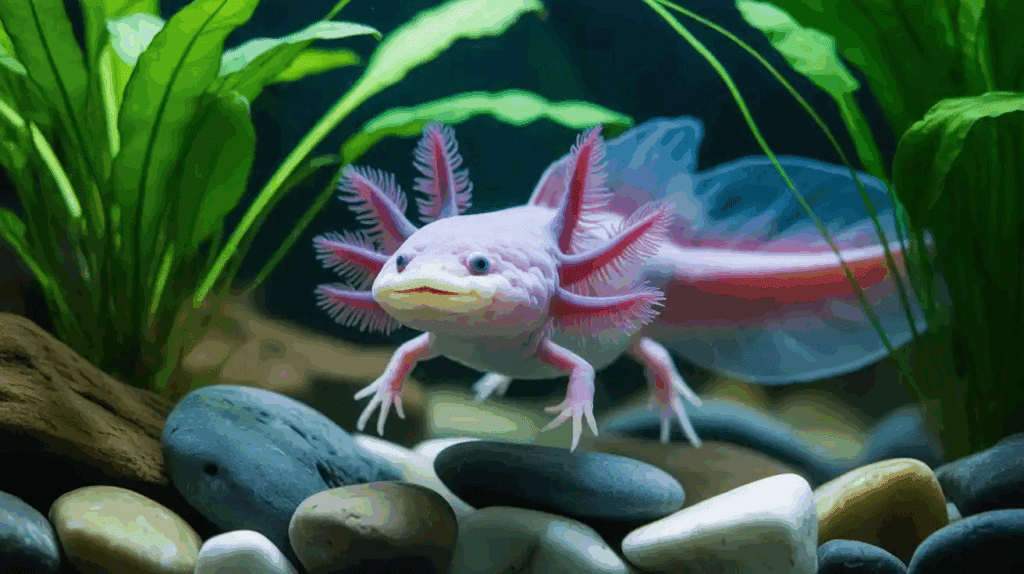Ever wondered what makes axolotls so special?
Many pet owners struggle to understand why these little water creatures have captured hearts worldwide. It’s frustrating when people can’t explain to friends why their axolotl is the coolest pet ever.
These amazing creatures can regrow entire limbs, breathe through their skin, and smile at their owners every single day. They’re like having a tiny dragon that never grows up.
Ready to fall even more in love with axolotls? Here are some (many) reasons why these creatures make absolutely wonderful companions.
Fun Facts About Axolotls That Will Wow You
Prepare to be floored by these extraordinary amphibians! Axolotls possess a remarkable ability to regenerate lost body parts, including their brain, heart, and entire limbs-a feat unmatched in the animal kingdom.
These unique creatures are critically endangered in the wild, with only a few hundred remaining in their native Mexican lakes.
-
Axolotls are neotenic, meaning they retain juvenile traits throughout their lives.
-
They breathe through external feathery gills, lungs, and their skin.
-
Axolotls can regenerate entire limbs, spinal cords, hearts, and parts of their brains.
-
Their gills resemble pink, feathery branches and extend from the sides of their heads.
-
They have tiny vestigial teeth but swallow their food whole.
-
Axolotls have no eyelids—so they sleep with their eyes open.
-
Their skin can be permeable, aiding in respiration and toxin absorption.
-
The heart of an axolotl can regenerate after injury.
-
They possess the unique ability to regenerate limbs without scarring.
-
Axolotls can regrow the same limb multiple times in their lifetime.
-
The wild-type axolotl is dark with greenish and black speckles.
-
Leucistic axolotls are pale pink or white with black eyes.
-
Albino axolotls are golden or white with red eyes.
-
Melanoid axolotls are completely black and lack iridophores (shiny pigments).
-
GFP (Green Fluorescent Protein) axolotls glow under UV light due to genetic modification.
-
Piebald axolotls have irregular patches of color on a pale body.
-
Axolotls can recognize their owners and react to feeding cues.
-
They are mostly nocturnal and more active during the night.
-
They can be trained to take food from tweezers.
-
Axolotls are generally solitary and don’t require tank mates.
-
When stressed, their gills may shrink or their color may change slightly.
-
They are curious and may interact with objects or hands in their tanks.
-
Axolotls are native to the lakes of Xochimilco and Chalco in Mexico.
-
They prefer cool, still, freshwater environments.
-
They require low-flow tanks as strong currents stress them.
-
Their natural habitat is now critically endangered due to urbanization and pollution.
-
Axolotls are considered critically endangered in the wild.
-
They are carnivorous and eat worms, small fish, and insects.
-
In captivity, they are often fed bloodworms, brine shrimp, and pellets.
-
They use suction to ingest food by opening their mouths quickly.
-
Axolotls don’t have stomachs; food passes directly to their intestines.
-
Males deposit sperm packets that females pick up with their cloaca.
-
Females can lay hundreds of eggs at a time.
-
Axolotl eggs are gelatinous and typically attach to plants or decorations.
-
Larvae hatch in about two weeks, depending on temperature.
-
Axolotls typically reach sexual maturity by 6 to 12 months of age.
-
Axolotls are a model organism in regeneration research.
-
Their genome is 10 times larger than the human genome.
-
Scientists study them to understand limb regeneration in humans.
-
They played a key role in early studies of embryology.
-
Axolotls can accept organ transplants with minimal rejection due to unique immune systems.
-
Axolotls should be kept in tanks at 16–18°C (60–64°F).
-
Gravel can cause impaction; sand or bare-bottom tanks are safer.
-
They should not be handled unless necessary, as it stresses them.
-
Axolotls do best in a species-only tank to avoid injury or stress.
-
They can live up to 15 years in captivity with proper care.
-
They don’t require lighting and prefer dim environments.
-
The name “axolotl” comes from Nahuatl, meaning “water dog” or “water monster.”
-
Axolotls were associated with the Aztec god Xolotl.
-
They appear in Mexican mythology as the twin brother of Quetzalcoatl.
-
Axolotls are featured on Mexican currency and stamps.
-
They are amphibians, not fish—despite their aquatic lifestyle.
-
Axolotls are entirely aquatic their whole lives (unlike most salamanders).
-
They can regenerate eyes, jaws, and even parts of their brain.
-
A single axolotl can regenerate multiple body parts at once.
-
They were first brought to Europe in the 1860s.
-
The axolotl population in captivity vastly outnumbers those in the wild.
-
Axolotls can regenerate portions of their jaws and tails even as adults.
-
They can also regrow damaged lungs.
-
Their spinal cord regeneration includes reformation of nerves and connective tissue.
-
Axolotls can regenerate the lens of their eyes.
-
They show no reduction in regenerative ability with age.
-
Their regenerative cells behave like stem cells, reverting to a primitive state.
-
Axolotls do not form tumors when regenerating, a key interest for cancer research.
-
Scientists can study cancer resistance in axolotls due to their unique cell behavior.
-
Their immune system is adapted to support regeneration rather than rapid inflammation.
-
Axolotls have more chromosomes (14 pairs) than humans (23 pairs).
-
Their genome size is roughly 32 billion base pairs long.
-
Axolotls are part of the Ambystomatidae family, a group of mole salamanders.
-
Although aquatic, axolotls have rudimentary lungs and occasionally surface for air.
-
Axolotls have two sets of nostrils—external and internal—to assist with smell.
-
Unlike frogs, axolotls never go through metamorphosis naturally.
-
In rare cases, axolotls can be induced to metamorphose using thyroid hormone.
-
Metamorphosed axolotls resemble terrestrial salamanders and lose their gills.
-
Metamorphosis is stressful and often shortens their lifespan.
-
Their bones are softer and more cartilaginous than those of other amphibians.
-
They possess lateral line organs that detect vibrations in the water.
-
Axolotls thrive in water pH between 6.5 and 8.0.
-
High temperatures can cause stress and illness in axolotls.
-
A temperature over 23°C (73°F) for long periods can be fatal.
-
Their native habitat is fed by cold mountain springs.
-
The canals of Xochimilco are now the last place axolotls exist in the wild.
-
Floating islands called “chinampas” are part of their natural wetland ecosystem.
-
Non-native fish species like tilapia have threatened axolotl populations.
-
Conservation groups are trying to reintroduce axolotls into protected reserves.
-
The Xochimilco wetland is also a UNESCO World Heritage Site.
-
Wild axolotls are extremely rare and difficult to find.
-
Axolotls were the first vertebrates cloned successfully.
-
Their transparent embryonic development makes them ideal for observation.
-
Scientists use CRISPR to edit axolotl genes for regeneration studies.
-
Axolotls can regrow limbs complete with bones, muscles, blood vessels, and nerves.
-
Their regenerative capacity surpasses that of frogs and newts.
-
Research on axolotls may one day help humans heal spinal injuries.
-
Studying axolotl regeneration could lead to scarless wound healing.
-
Axolotls can regenerate skin without fibrosis, unlike humans.
-
Regenerated axolotl limbs function almost identically to the original ones.
-
Axolotls are frequently studied in developmental biology for organ formation.
-
Regenerative gene expression in axolotls occurs within hours of injury.
-
New blood vessels form in just a few days after limb loss.
-
NASA has studied axolotls in space to understand regeneration in microgravity.
-
Axolotls are an important subject in comparative genomics.
-
Axolotls can show mood changes through body color—darker when stressed.
-
They can gulp air from the surface in low-oxygen conditions.
-
Pet axolotls often follow movement outside the tank with interest.
-
They sometimes “yawn” to adjust their gill position or flush water through gills.
-
Axolotls can float if they swallow too much air.
-
Some axolotls develop temporary “bubble butt” from trapped air.
-
They may occasionally rest motionless for long periods without worry.
-
Each axolotl has a unique personality—some are shy, others more curious.
-
Tankmates, even other axolotls, may be mistaken for food if size differs greatly.
-
Young axolotls are more aggressive and prone to nipping.
-
Feeding axolotls with tongs can prevent them from eating substrate.
-
Their eyesight is poor—they rely on movement and smell.
-
Axolotls may not react to food that doesn’t move.
-
Bright light may make them hide or stop eating.
-
They enjoy hiding places like caves or plants for security.
-
Sudden temperature spikes can cause hyperactivity or illness.
-
Most axolotls prefer not to be handled at all.
-
They are happiest when left alone in a stable, clean tank.
-
A single axolotl needs at least a 20-gallon tank.
-
Axolotl eggs are around 1–2 mm in diameter.
-
Egg hatching time varies between 10 to 14 days.
-
Baby axolotls are called “larvae” and are entirely aquatic from birth.
-
Larvae require separation to avoid cannibalism during growth.
-
Juvenile axolotls regenerate faster than adults.
-
Most breeding occurs in early spring or after a water temperature drop.
-
Female axolotls can become egg-bound if not given proper conditions.
-
Breeding axolotls requires stable temperature and calm environments.
-
Axolotls are sexually dimorphic—males have a swollen cloaca.
-
With proper care, axolotls can live up to 15–20 years.
-
Axolotls have been featured in Pokémon (Wooper and Quagsire are inspired by them).
-
They were considered a delicacy in Aztec times.
-
Diego Rivera painted axolotls in murals of Mexican life.
-
Frida Kahlo kept pet axolotls in jars in her studio.
-
Axolotls are sometimes called “Mexican walking fish,” though they’re not fish.
-
In Japanese culture, fried axolotls are sold as novelty food.
-
Axolotls have become viral pets on TikTok and Instagram.
-
They are featured in Minecraft as friendly aquatic mobs.
-
Schools and museums often keep axolotls for educational purposes.
-
The axolotl was declared critically endangered by the IUCN Red List.
-
Axolotls can absorb water through their skin.
-
They are more active after water changes or feeding.
-
They can regrow parts of their liver and kidneys.
-
Stress can cause axolotls to shed their slime coat.
-
They don’t have external ears but can sense low-frequency sounds.
-
Their smile-like expression is due to their fixed mouth shape.
-
Axolotls do not make sounds, though they may gulp or click during feeding.
-
A group of axolotls is humorously called a “squiggle.”
-
Their poop is often long and jelly-like, easily cleaned.
-
Axolotls have become conservation ambassadors for amphibians worldwide.
-
Some scientists propose axolotls as a model for anti-aging research.
-
Their gill filaments are lined with blood vessels for maximum oxygen exchange.
-
UV light should be avoided as it stresses their sensitive skin.
-
Aquarium chillers are sometimes used in warm climates to keep them healthy.
-
Large axolotls may grow over 12 inches long, though 9 inches is typical.
-
Their tank water should be dechlorinated before use.
-
Axolotls can suffer from “floating syndrome” if fed fatty foods like waxworms.
Can You Have an Axolotl as a Pet?
Owning an axolotl as a pet requires specialized care and commitment.
These unique aquatic salamanders need a carefully maintained environment with cool water temperatures between 60-64°F, making them challenging for novice pet owners.
Potential axolotl owners must invest in a spacious tank with pristine water conditions, specific filtration systems, and a diet of live or frozen foods like bloodworms and brine shrimp.
Legal considerations are crucial, as axolotl ownership is restricted in some regions like California and New Mexico.
Responsible care includes maintaining water quality, providing hiding spaces, and avoiding handling, as axolotls have delicate skin that can be easily damaged.
Wrapping It Up
So there you have it – 157 reasons why axolotls are truly special pets.
From their ability to regrow limbs to their constant smiles, these water creatures bring something unique to every home. They’re not just pets; they’re living proof that nature still has surprises for us.
Why does this matter? Because finding the right pet can change your entire daily routine. Axolotls offer companionship without the usual pet stress. No walking in rain, no loud barking, just peaceful moments watching your little friend swim around.
Don’t forget to share your favorite axolotl moment in the comments below
















